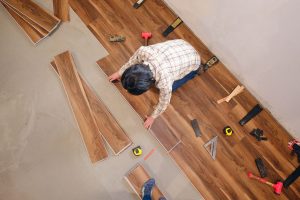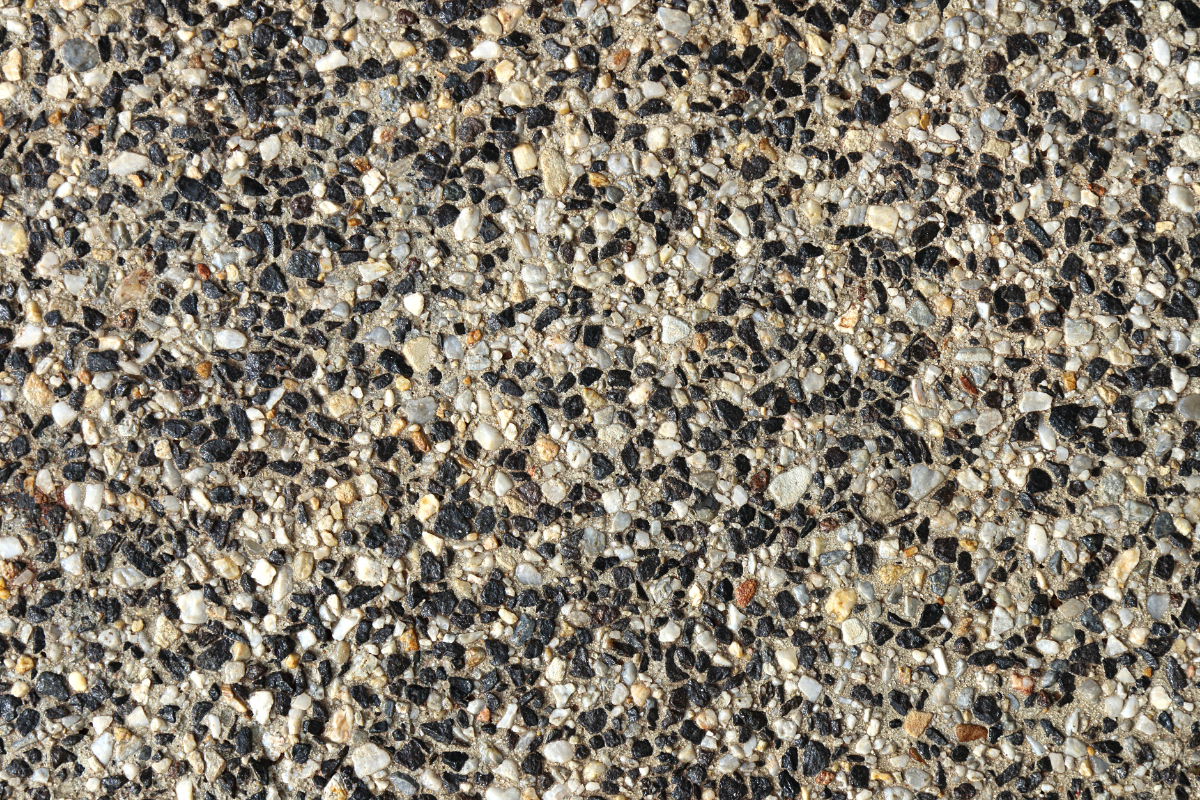Table of Contents
Your driveway is the last thing you see before you leave and the first thing you see when you arrive home. So, if there’s anything that could increase your home’s curb appeal, then redoing your plain, boring concrete driveway with exposed aggregate might be the most impactful thing you can do.
What is exposed aggregate?
Exposed aggregate refers to a decorative finish applied to concrete to show off those small stones, pebbles, or even sand that are hidden within the concrete, giving it a visually appealing and textured appearance. Some folks even call it Pebblecrete because of its unique look.
But it’s not just for aesthetics; the exposed pebbles provide a textured surface that improves traction. This effectively reduces the risk of slipping, making it suitable for areas such as walkways, driveways, and pool decks.

How much is an exposed aggregate driveway?
The cost of an exposed aggregate driveway varies depending on several factors, such as the size of the surface area, type of finish, and geographical location. On average, the cost for exposed aggregate concrete can range from $90 to $150 per square metre.
Here is an approximate breakdown of the average cost of exposed aggregate concrete driveways in Australia:
| One-car driveway | $1500 |
| Two-car driveway | $2750 |
| Three-car driveway | $4000 |
How much is a honed aggregate driveway?
For an even more premium look, honed aggregate is also an option you can choose for your driveway. Honed aggregate is a type of concrete that has been polished to give it a smooth surface that makes it look more polished. This option will cost you more but provides an additional benefit of being easier to clean.
Honed Aggregate costs about $100 – $180 per square metre. Here’s how much you’re going to have to pay for that premium, honed aggregate driveway:
| One-car driveway | $1650 |
| Two-car driveway | $3300 |
| Three-car driveway | $4500 |
It’s important to note that these are rough estimates, and prices may fluctuate depending on the specific project requirements and the region where the work is being carried out.
How much does an exposed aggregate concrete driveway cost per square metre?
The cost of an exposed aggregate concrete driveway in Australia can range from $90 to $150 per square metre. However, this can still be affected by factors such as the size of the area, type of finish (honed or bare), and geographical location. Additionally, the type of concrete used can also impact the price.
Here are some of the average costs of standard exposed aggregate driveways per sqm. in some of the major Australian states:
| Queensland | $135 per sqm |
| South Australia | $135 per sqm |
| Victoria | $135 per sqm |
| New South Wales | $140 per sqm |
| Western Australia | $145 per sqm |
Exposed aggregate driveway cost vs polished concrete
Another popular alternative to bare concrete driveways is polished concrete. They’re a type of concrete polished to a high gloss finish, making it look almost like stone.
And since polishing concrete needs a little bit more elbow grease than some exposed aggregate techniques, it’s more expensive, however, slightly cheaper than a honed aggregate driveway.
Polished concrete costs around \$100 per sqm. compared to exposed aggregate’s cost of $90 per sqm.
Is exposed aggregate concrete more expensive than normal class concrete?
Because of the additional layer of aggregates and additional labour needed to install, exposed aggregate is definitely more expensive. A bare concrete pavement costs just \$65 – \$85 per sqm. while exposed aggregates cost around $90 – $150, depending on the type of finish you’d like to use.
Factors that affect the cost of your exposed aggregate concrete
The cost of all driveway projects, including exposed aggregate, depends on a number of extraneous factors. While some can be adjusted depending on the homeowner’s budget, some factors, such as the market price and demand for the service, will affect the total price.
Here are several of the most impactful factors that will affect the overall cost of the project:
- Project Size: Generally, larger areas will require more materials and labour, which can drive up prices. So, if you’re planning a three-car driveway, prepare to pay quite a bit more than your standard-sized driveway.
- Aggregate Selection: There are various aggregate options available, ranging from natural stones like granite and marble to recycled glass or shells. Some aggregates may be more expensive due to procurement difficulties, while others may cost a lot less. So, if you’ve got your heart set on a certain type of stone, just keep in mind that it may come with a higher price tag.
- Complexity of Design: If you want a specific pattern, colour combination, or custom shape, it may require additional expertise and man hours to accomplish. This would take your overall costs beyond your standard aggregate concrete driveways.
- Location: Where you live can also play a role in the cost of exposed aggregate concrete. Prices can vary depending on the region and local market conditions. So, if you’re in a high-demand area or a remote location where transporting materials can be costly, it could impact your overall costs.
- Site Preparation: Preparing the site for the installation of exposed aggregate concrete can also affect the cost. If the area needs extensive excavation, removal of existing materials, or grading, it can require additional labour and equipment, adding to the overall expense.
- Slope: Even bare concrete driveways cost more than typical projects if the site has a bit of a slope to it. Slopes can be problematic for many concrete applications, but they pose a special challenge with exposed aggregate concrete. Slopes make it more difficult to create a smooth and consistent surface for the poured concrete, increasing labour costs.

People Also Ask
Is exposed aggregate concrete worth it?
If you have ever slipped on a wet bare concrete driveway, then you probably understand the value of getting slip-resistant driveway pavements. Exposed aggregate concrete provides one of the best traction for both shoes and wheels, which makes it a safer choice than other driveway material options. Plus, it’s low maintenance, durable, and has a warmer appeal than bare concrete. It’s also not a lot more expensive than concrete.
How thick should exposed aggregate concrete be?
To ensure durability, exposed aggregate driveways need to be at least 100 mm thick. This thickness ensures that the aggregate stays put and doesn’t flake off over time. It also provides enough space for expansion joints to prevent cracks from forming in the pavement. While 100 mm is a minimum, you may want to go thicker if you’re planning on using heavy equipment on your driveway or if it’s going to be exposed to harsh weather conditions.
Is exposed aggregate stronger than concrete?
It’s worth noting that the appearance and decorative nature of exposed aggregate concrete can sometimes give the impression of increased strength or durability. However, the strength of the concrete itself will depend on its composition and not just the presence of exposed aggregates.
How long does exposed aggregate take to set?
The full strength of normal concrete is typically achieved after 28 days of proper curing and moisture control. Exposed aggregate generally sets and hardens at a similar rate. However, it is important to note that the curing process is crucial in developing the maximum strength of the concrete. This process involves keeping the concrete moist and protected from drying out too quickly, allowing it to continue hydrating and gaining strength over an extended period.
Related Flooring Resources

How Much Does It Cost To Remove Slate Flooring
Table of Contents How much does it cost to remove slate flooring? The cost to remove slate flooring in Australia typically ranges from $30 to

How Much Does Hybrid Flooring Cost
Table of Contents How Much Does Hybrid Flooring Cost Hybrid flooring in Australia typically costs between $35 to $70 per square meter, with additional expenses

Bamboo Flooring Installation Cost
Complete guide to bamboo flooring installation costs – materials, labor, hidden fees and budgeting tips to avoid overspending.

